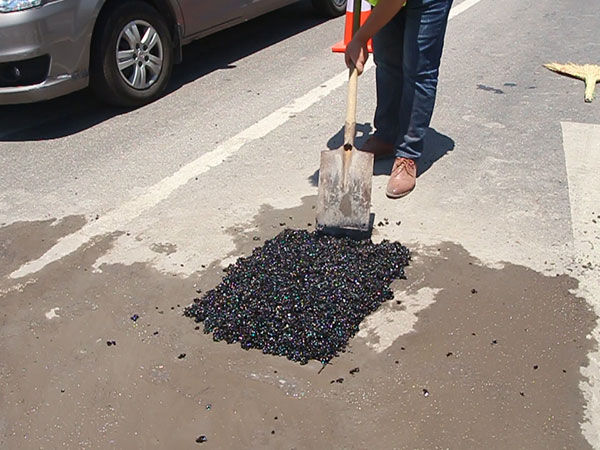Maximizing the Durability of Cold Mix Asphalt Pavements
- High Roads
- Jun 13, 2023
- 3 min read

Asphalt pavements are widely used in various infrastructure projects due to their durability, cost-effectiveness, and ease of construction. Among the different types of asphalt pavements, cold mix asphalt has gained significant popularity. Cold mix asphalt offers several advantages, including the ability to be used in remote areas and during colder weather conditions. However, to ensure the long-term durability of cold mix asphalt pavements, certain factors must be considered during the construction and maintenance processes. In this article, we will explore key strategies for maximizing the durability of cold mix asphalt pavements.
1. Introduction
Cold mix asphalt is an asphalt mixture that can be produced and applied at ambient temperatures. Unlike hot mix asphalt, which requires heating, cold mix asphalt is ready to use right out of the bag. This characteristic makes it a convenient choice for temporary repairs, remote locations, and emergency situations. However, to ensure the durability of cold mix asphalt pavements, proper construction and maintenance practices are essential.
2. Understanding Cold Mix Asphalt
Cold mix asphalt is composed of aggregates, bitumen emulsion, and filler materials. The aggregates provide strength and stability, while the bitumen emulsion acts as the binder that holds the mixture together. The filler materials help improve the overall performance of the asphalt. Compared to hot mix asphalt, cold mix asphalt has a lower viscosity, making it easier to work with at ambient temperatures.
3. Factors Affecting Durability
Material Selection
Choosing the right materials for cold mix asphalt is crucial for maximizing its durability. High-quality aggregates with proper gradation and particle size distribution ensure a strong and stable pavement. The bitumen emulsion should have appropriate viscosity and adhesive properties to promote good bonding between the aggregates.
Moisture Control
Moisture is one of the main factors that can adversely affect the performance of cold mix asphalt pavements. Excessive moisture can lead to softening of the mixture, reduced cohesion, and increased susceptibility to damage. Proper drainage and the use of water-resistant additives can help mitigate moisture-related issues.
Compaction Techniques
Effective compaction is essential for achieving a dense and durable cold mix asphalt pavement. Compaction helps eliminate voids and enhances the load-bearing capacity of the pavement. Vibratory rollers or plate compactors can be used to achieve adequate compaction levels.
Proper Layer Thickness
The thickness of the cold mix asphalt layer is crucial for its long-term durability. Insufficient thickness can result in premature cracking and structural failures. It is important to follow the recommended thickness guidelines provided by the manufacturer or relevant industry standards.
4. Construction Best Practices
To ensure the longevity of cold mix asphalt pavements, the following construction best practices should be followed:
Base Preparation
Proper preparation of the base is essential for a stable and durable pavement. The base should be compacted and free from any debris or loose materials. If necessary, a geotextile fabric can be used to improve the stability and prevent the migration of fines.
Mixing and Placement
During the mixing and placement process, it is important to achieve a uniform distribution of aggregates and proper coating with the bitumen emulsion. The mixture should be thoroughly mixed to ensure good workability and homogeneity. Care should be taken to avoid segregation and ensure consistent quality.
Rolling and Compaction
Rolling and compaction should be carried out immediately after the placement of the cold mix asphalt. Adequate compaction ensures the achievement of the desired density and minimizes the presence of air voids. Multiple passes with appropriate compaction equipment should be performed to achieve optimal results.
5. Maintenance and Repair
Regular maintenance and timely repairs are essential for preserving the durability of cold mix asphalt pavements. The following practices can help prolong the lifespan of the pavement:
Regular Inspections
Periodic inspections should be conducted to identify any signs of distress, such as cracks, potholes, or surface deterioration. Early detection allows for prompt repairs and prevents further damage.
Crack Sealing
Cracks should be promptly sealed to prevent moisture infiltration and the spread of cracks. Crack sealants can help restore the integrity of the pavement and prevent further deterioration.
Patching and Overlay
When significant damage occurs, patching or overlaying the affected areas may be necessary. Proper preparation and adherence to recommended procedures are essential for achieving durable repairs.
6. Environmental Considerations
In addition to the construction and maintenance practices, considering environmental factors can further enhance the durability of cold mix asphalt pavements. Using sustainable materials, incorporating recycling practices, and implementing proper stormwater management techniques contribute to the overall longevity of the pavement.
7. Conclusion
Maximizing the durability of cold mix asphalt pavements requires careful attention to material selection, construction techniques, and maintenance practices. By following best practices and considering environmental factors, it is possible to achieve long-lasting and reliable asphalt pavements. Cold mix asphalt offers flexibility and convenience, making it a valuable option for various applications. With proper care and proactive maintenance, cold mix asphalt pavements can withstand the test of time and provide a smooth and durable surface for years to come.





Comments